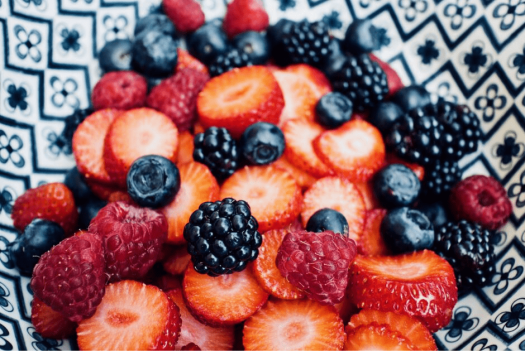By: Annabelle Shaffer, BS, Master’s candidate in the Division of Nutritional Sciences at University of Illinois Urbana-Champaign
Dietary Approaches to Stop Hypertension (DASH diet) was developed in conjunction with the National Institutes of Health (NIH) as a dietary treatment to reduce high blood pressure. Similar to a Mediterranean eating pattern, the DASH diet emphasizes whole grains, fruits, vegetables, low-fat dairy products, lean proteins, and a limited intake of saturated fats and sugar.1 This eating pattern provides key nutrients for blood pressure reduction: calcium, potassium, and magnesium.1 Along with the consumption of nutrient-dense foods, the DASH diet emphasizes a reduction in sodium and saturated fats.1
Why Use the DASH Diet?
Blood pressure reduction is the most well-known outcome of following the DASH diet, specifically the low-sodium version.2 Americans eat large amounts of sodium (3600 mg daily is the average), as it is found in packaged foods, fast foods, restaurant meals, and is naturally contained in several foods.3 A high sodium diet leads to increased blood pressure because salt disturbs the water balance in our kidneys leading to a larger blood volume which stresses our cardiovascular system. On the DASH diet, it is ideal to consume less than 1 teaspoon of table salt (2300 mg sodium) daily for the Standard DASH Diet, or one-half teaspoon (1500 mg sodium) for the lower sodium pattern.
In addition to lowering blood pressure, the DASH diet is cardioprotective. High adherence to the diet is associated with a lower risk of heart attack, stroke, and death due to cardiovascular disease.4 Furthermore, following the DASH diet leads to improved blood lipid levels.3
Adding a Dash of DASH into Your Diet!
Everyone can improve their diet by using DASH diet principles. Here are some easy ways to add a dash of DASH into your daily life!
- Limit your intake of sugar-sweetened sodas, coffees, and juices. Try to swap these drinks for their unsweetened counterparts, such as black coffee or unsweetened tea, water, or low-fat unflavored dairy.
- Aim to have a lean protein source at every meal. Lean proteins include low-fat dairy, beans, poultry, fish, and lean beef. Dairy products provide calcium and protein – double win!
- Utilize whole fruits and vegetables as snacks. Apples, bananas, carrot sticks, bell peppers, and pears are all great on-the-go snacks.
- Swap your refined grains (white rice, pasta, white bread) for whole grains (brown rice, whole-wheat pasta, and whole-wheat bread). Whole grains pack a lot of nutrients without a major taste change!
- When cooking, utilize unsaturated fats such as olive or canola oil. Avoid using butter or coconut oil as these are a source of saturated fats.
For more information on reducing blood pressure using the DASH diet, see this guide from the NIH.
References
- How to make the DASH diet work for you. (2019). Retrieved 16 September 2019, from https://www.mayoclinic.org/healthy-lifestyle/nutrition-and-healthy-eating/in-depth/dash-diet/art-20048456
- Stamler, J., Chan, Q., Daviglus, M., Dyer, A., Van Horn, L., & Garside, D. et al. (2018). Relation of Dietary Sodium (Salt) to Blood Pressure and Its Possible Modulation by Other Dietary Factors. Hypertension, 71(4), 631-637. doi: 10.1161/hypertensionaha.117.09928
- DASH Eating Plan | National Heart, Lung, and Blood Institute (NHLBI). (2019). Retrieved 16 September 2019, from https://www.nhlbi.nih.gov/health-topics/dash-eating-plan
- Jones, N., Forouhi, N., Khaw, K., Wareham, N., & Monsivais, P. (2018). Accordance to the Dietary Approaches to Stop Hypertension diet pattern and cardiovascular disease in a British, population-based cohort. European Journal Of Epidemiology, 33(2), 235-244. doi: 10.1007/s10654-017-0354-8
Photo by: Canva















